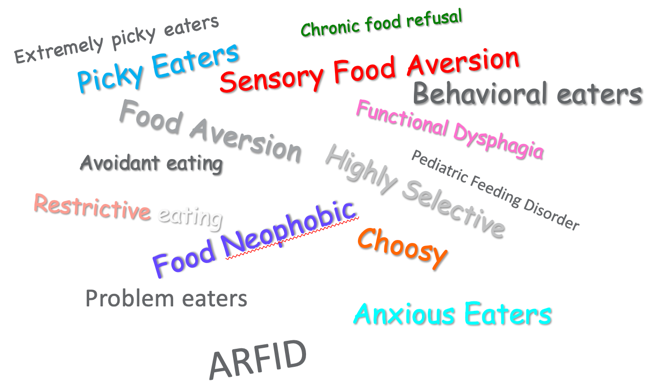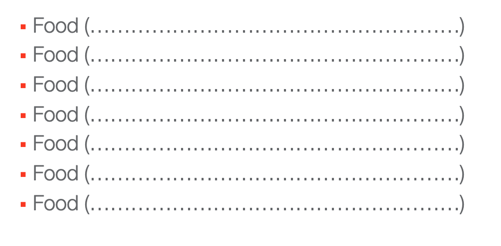Introduction
Marsha: Hello everyone! I would like to share some ideas with you about anxious eaters and anxious mealtimes today. I just finished a book on the topic so I am pretty excited about this topic.
Picky Eaters
Who are those picky eaters? They can be called many names as seen in Figure 1.

Figure 1. Other names for picky eaters.
Some of you think of this population as extremely picky eaters, chronic food refusers, behavioral eaters, anxious eaters, problem eaters, food neophobic, restrictive eating, ARFID, which is Avoidant Restrictive Food Intake Disorder, or as having a sensory food aversion. Some of them are also called highly selective, and some might have dysphagia.
Anxious Eaters
There can be a lot of different terms that are used, but for the purpose of this talk today, we are going to refer to these children as anxious eaters and look at the worry aspect of what is going on with their eating. We are going to talk about children who are worried about a very specific look, a very specific sound, smell, texture, or taste for foods. Changing from any of those sensory variables is very worrisome for this crowd, and we are going to look at the big concepts of worry and change when those are difficult for these kids. Some of these kids have a diagnosis of food neophobia. This is a term that was coined a while back, Leanne Birch popularized it, and they talked about the fear of a new food introduction. I like that term a lot for these kiddos because many of them are actually fearful and overly worried about new food presentations. However, Leanne Birch and others talked about this as being a typical stage in toddler development. However, I think the children that we are talking about today are not typically developing toddlers that get a little bit picky for a while and then outgrow it. These are children where the food worry is really real.
Diagnoses
- Food neophobia
- Sensory processing disorders
- Autism
- Obsessive-compulsive or anxiety disorder
- ARFID (Avoidant Restrictive Food Intake Disorder)
- What they ALL have is worry
Some of these kiddos have sensory processing disorders, as diagnoses, but we have many children with sensory processing disorder diagnoses who do not have any eating issues. So, this term does not work that well. Many children with a diagnosis of autism do have picky eating and anxious eating issues; however, again, not all children with feeding challenges have autism. Some of these kiddos have obsessive-compulsive or anxiety disorders that are diagnosed or undiagnosed. It might fit with the Avoidant Restrictive Food Intake Disorder crowd, but there is a lot of controversy and discussion about whether that term fits all of these children, and who should treat them. For the purpose of this talk, let's just talk about the kids that have eating challenges where worry is the biggest challenge.
The List (Parentheses Diet)
I like to think of these kiddos as having a parentheses diet.

Figure 2. Parentheses Diet.
The children that we are talking about would be those with limited diets. For example, if we asked the parent, "What foods does your child eat on a regular basis?" They would say, "There's four." Or, "There's seven." What I ask them to do is tell me about their child's food preferences. They might identify yogurt. And then I will say, "Ok yogurt. I am going to write in the parentheses what it is I need to know about yogurt. If I were babysitting for your child and I needed to have it be a successful meal, what do I have to know about that yogurt?" The parent might say, "It needs to be blueberry yogurt whipped." They may also identify a certain brand, type of container, and how it has to be opened right in front of their child. The next food might be chicken. The information about the chicken in the parentheses may include that the chicken needs to be nuggets, from McDonald's, cannot be broken, and cannot be any other shape than round. Here is another example of pancakes. The additional information may include that they need to be dollar-sized Eggo brand. Or for crackers, they need to be only Ritz or yellow Goldfish. This list is where parents describe their child's list of favorite foods. We used to call them safe foods, but I like to call them favorite foods now. I want to get away from the term "safe." The information in the parentheses tells you about their "worry." They like yogurt, they have the oral/motor skills to eat yogurt, and they can eat smooth purees, but it must be one brand, one color, one shape, and on a certain plate. It is the specificity of what they like about that yogurt that can help to identify the specificity of the worry.
Parents Describe
- “He seems terrified of new foods…..”
- “He seems to hate mealtimes…”
- “I cannot change A THING about the meal or she falls apart…”
- “He is anxious, he is worried, he is so stressed!”
Parents will often describe these kids as seemingly terrified of new foods or hating mealtimes. A parent might say, "I can't change a thing about the mealtime or the child falls apart." Or, "He's anxious, worried, and so stressed." These are phrases that we hear over and over again.
Imagine Yourself With Worry
- Imagine a giant grown-up wanted YOU to try a food that, for some reason worried you immensely.
- Maybe you hated the look
- Maybe the smell made you nauseous
- Maybe the sound of someone crunching it was like fingers on a blackboard
- Maybe the texture made you gag
- Maybe the taste was NOT RIGHT!
- Would you want someone to make YOU eat that food?
I have been working on feeding for five decades, and it has always has been a certain part about trying it myself. Imagine that a giant, grown-up person wants you to try a food that, for some reason, worries you immensely. Maybe you hate the look of it. I hate the look of octopus tentacles on my plate, but I do not mind octopus if it is cut in small pieces. Maybe the smell makes you nauseous. Why would you put that in your mouth? Maybe the sound of somebody else crunching it is particularly worrisome to you. Maybe that texture has made you gag in the past, and there is no way you want to put it in your mouth. Maybe the taste is not right. Perhaps, it is a food from another country, and it is fermented. It might be perfectly normal, but in your mouth, it is not a usual experience. The idea is that if any aspect of the food was particularly difficult for you, would you want somebody else to make you eat it? I am not saying it is logical why these kids do not particularly like the foods, but to them, it is personal and real.
Child Challenges
- Poor nutrition can affect health
- Narrow colors or textures
- Sensitive to sensory variables (smell, look, texture taste and sound)
- Visually hypervigilant
- Highly stressful meals
- Difficulty transitioning to meals
- Suspicious of change
- No mealtime enjoyment or limited motivation
We end up with children that have poor nutrition, and this can also certainly affect their health. When you have a limited number of foods, often there are any fruits or vegetables in sight. There also may be a lot of carbohydrates. This is going to narrow their nutritional content. For a lot of these kiddos, there is also a very narrow color range with lots of beiges, whites, browns, and a little yellowish-orange, like macaroni and cheese from Kraft. These children are also often are very sensitive to a particular smell, look, texture, taste, or sound. When children are really worried about change, what ends up happening is they can become hypervigilant visually. They will scan the mealtime and notice immediately if you have changed something. "There are brown flecks on my pizza crust." "The pancake isn't the right color." "There's something in my pancake that might be a blueberry. I do not want it." They spend a lot of time hyper vigilantly worrying about the look of their mealtime. When you have to spend your time worrying about defending yourself against a change at mealtime, it makes mealtime less and less enjoyable. Mealtime has now become highly stressed, and these children have difficulty transitioning to their meals. Why would you want to go to mealtime when you have been playing a game on your computer that you like. Now, somebody wants you to come to a mealtime where you do not like any of the sensory aspects of that meal? These kiddos become really suspicious of change, and that is partly our fault. As the grownups who care about these children, we have probably tried to sneak in something new to see if they would notice. And, for these children that did notice it, they are going to be suspicious that we might sneak in a change. They are constantly looking for sensory surprises. And, of course, there is not going to be mealtime enjoyment when there is this much worry. There is also limited motivation to try new things.
Parent Challenges
- Picky eating, choices not logical
- Poorly balanced diet
- Can’t change diet, presentation, brand, environment
- Hard for the family to eat together
- Emotional impact
- Doctors not concerned
- Friends and family do not get it!
- Eating out is stressful!
Parents also have challenges. When a child is a picky eater, it is hard to understand why they do not like a particular food. Their choices are not logical. "You like yogurt. Why do not you like this yogurt? They can be the same texture or color, but it happens to be a different flavor. It is not a logical choice from our perspective. However, from their perspective, it is a real worry, and we need to believe these kids. Kids also have a poorly balanced diet which worries parents. Parents cannot change the diet, the presentation, the brand, the environment, and maybe not even the feeder. It can be hard for families to eat together. This has a huge emotional impact on both children and families. Doctors often are not concerned because many times these children are growing just fine. They may be growing fine, but the parent is worried that they only eat four foods. Parents can feel dismissed by medical support. Families and friends do not get it. Many parents hear, "If you wouldn't give him snack food all the time, he'd probably eat other things." This is as if these parents have not already tried lots and lots of different foods. Eating out can also be very stressful.
Our Support Could Focus On...
- Behavior…Could we think of the behavior “problem” as the child’s way of communicating to us that there IS a problem? Are we listening?
- Diet…Get new foods in…how?
- Sensory…If too much too fast the child falls apart
- I focus on fear and worry about change……
- I have found answers in the phobia literature.
We could focus our support on a lot of different things. I do not like to call these children "behavioral problems." I like to think of the resistance the child is showing us as the child's ways of communicating to us that there is a problem. Ellyn Satter, dietician and leading expert on feeding throughout the country, talks about when children are resisting our offer, then we ought to look at what kind of pressure we are providing. Pressure can cause children to demonstrate more resistance. You could call it a behavior problem, but I would personally rather say they are trying to communicate something to us, and we should be listening and adapting our offer. Dieticians will tell these parents all the time that they need to add fruits, vegetables, and other food groups. Parents are aware of this, but they are not sure how to do it. One of the things we have to be aware of is that if we offer too much sensory change too fast, these worried eaters can fall apart. I like to focus on tiny steps in supporting the fear and worry and helping them get to a new place using incremental bits of change. I have found also found support in the literature on phobia.
Systematic Desensitization
Definition
- A process that uses principles of classical conditioning to replace a person’s phobia or fear response with a new response. It creates a hierarchy of situations that elicit a fearful response starting with the most comfortable starting place and working towards the most fearful.
The literature on phobia talks about the development of classical conditioning called systematic desensitization. This is actually a process that uses principles of classical conditioning to replace a person's phobia or fear response with a new response. It creates a hierarchy of situations that elicit a fearful response starting with the most comfortable starting place and working towards the most fearful. When we look at systematic desensitization throughout this talk, we are going to talk about it in the context of helping a child to like a food. We are going to start with where they are comfortable, and then, we are going to systematically make tiny, incremental steps of change in our offer. We want to help them stretch towards that new direction but without going right to the worry.
Steps
- Start with safe, FAMILIAR food or food presentation
- Tiptoe towards change
- Build on each change
- MUST be comfortable at each level before moving on!
We are going to start with what is safe, comfortable, and familiar, and then, we are going to tiptoe towards change. Then, we are going to build on each change. The main thing about systematic desensitization is each time there is a change, you have to get perfectly comfortable at that level before offering another level of change towards the goal. This will be more clear as we move along here.
Imagine an Elevator to a Tall Building
- Fear of heights
- Straight up to the top? (called Flooding in phobia literature)
- Or one floor at a time, getting comfortable at that floor before going up another floor
- Systematic and careful changes
I think this is a great analogy. You imagine that the child is on the first floor of a big, tall skyscraper, and you want to get them to the top. You could have them take the elevator and go fast. But if they have a fear of heights, it is going to really push their worry level. Instead, they could take one floor at a time, get comfortable there, and then, go up one more floor and so on. These are systematic, careful changes without pushing the child.
Continuum, Here to There
For the purposes of this talk, I want to talk about systematic desensitization in a practical term of a continuum. How can we help a child get from here to there?
- Start where the child is comfortable
- Tiptoe towards change
- Dilute the worry
We are going to start where the child is comfortable, tiptoe, and then dilute the worry.
